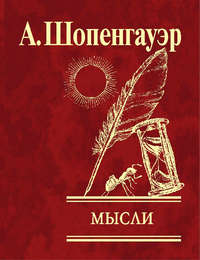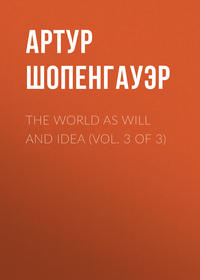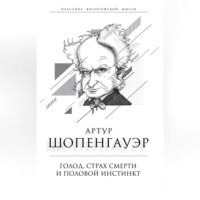 полная версия
полная версияThe World as Will and Idea (Vol. 1 of 3)
Let us imagine ourselves transported to a very lonely place, with unbroken horizon, under a cloudless sky, trees and plants in the perfectly motionless air, no animals, no men, no running water, the deepest silence. Such surroundings are, as it were, a call to seriousness and contemplation, apart from all will and its cravings; but this is just what imparts to such a scene of desolate stillness a touch of the sublime. For, because it affords no object, either favourable or unfavourable, for the will which is constantly in need of striving and attaining, there only remains the state of pure contemplation, and whoever is incapable of this, is ignominiously abandoned to the vacancy of unoccupied will, and the misery of ennui. So far it is a test of our intellectual worth, of which, generally speaking, the degree of our power of enduring solitude, or our love of it, is a good criterion. The scene we have sketched affords us, then, an example of the sublime in a low degree, for in it, with the state of pure knowing in its peace and all-sufficiency, there is mingled, by way of contrast, the recollection of the dependence and poverty of the will which stands in need of constant action. This is the species of the sublime for which the sight of the boundless prairies of the interior of North America is celebrated.
But let us suppose such a scene, stripped also of vegetation, and showing only naked rocks; then from the entire absence of that organic life which is necessary for existence, the will at once becomes uneasy, the desert assumes a terrible aspect, our mood becomes more tragic; the elevation to the sphere of pure knowing takes place with a more decided tearing of ourselves away from the interests of the will; and because we persist in continuing in the state of pure knowing, the sense of the sublime distinctly appears.
The following situation may occasion this feeling in a still higher degree: Nature convulsed by a storm; the sky darkened by black threatening thunder-clouds; stupendous, naked, overhanging cliffs, completely shutting out the view; rushing, foaming torrents; absolute desert; the wail of the wind sweeping through the clefts of the rocks. Our dependence, our strife with hostile nature, our will broken in the conflict, now appears visibly before our eyes. Yet, so long as the personal pressure does not gain the upper hand, but we continue in æsthetic contemplation, the pure subject of knowing gazes unshaken and unconcerned through that strife of nature, through that picture of the broken will, and quietly comprehends the Ideas even of those objects which are threatening and terrible to the will. In this contrast lies the sense of the sublime.
But the impression becomes still stronger, if, when we have before our eyes, on a large scale, the battle of the raging elements, in such a scene we are prevented from hearing the sound of our own voice by the noise of a falling stream; or, if we are abroad in the storm of tempestuous seas, where the mountainous waves rise and fall, dash themselves furiously against steep cliffs, and toss their spray high into the air; the storm howls, the sea boils, the lightning flashes from black clouds, and the peals of thunder drown the voice of storm and sea. Then, in the undismayed beholder, the two-fold nature of his consciousness reaches the highest degree of distinctness. He perceives himself, on the one hand, as an individual, as the frail phenomenon of will, which the slightest touch of these forces can utterly destroy, helpless against powerful nature, dependent, the victim of chance, a vanishing nothing in the presence of stupendous might; and, on the other hand, as the eternal, peaceful, knowing subject, the condition of the object, and, therefore, the supporter of this whole world; the terrific strife of nature only his idea; the subject itself free and apart from all desires and necessities, in the quiet comprehension of the Ideas. This is the complete impression of the sublime. Here he obtains a glimpse of a power beyond all comparison superior to the individual, threatening it with annihilation.
The impression of the sublime may be produced in quite another way, by presenting a mere immensity in space and time; its immeasurable greatness dwindles the individual to nothing. Adhering to Kant's nomenclature and his accurate division, we may call the first kind the dynamical, and the second the mathematical sublime, although we entirely dissent from his explanation of the inner nature of the impression, and can allow no share in it either to moral reflections, or to hypostases from scholastic philosophy.
If we lose ourselves in the contemplation of the infinite greatness of the universe in space and time, meditate on the thousands of years that are past or to come, or if the heavens at night actually bring before our eyes innumerable worlds and so force upon our consciousness the immensity of the universe, we feel ourselves dwindle to nothing; as individuals, as living bodies, as transient phenomena of will, we feel ourselves pass away and vanish into nothing like drops in the ocean. But at once there rises against this ghost of our own nothingness, against such lying impossibility, the immediate consciousness that all these worlds exist only as our idea, only as modifications of the eternal subject of pure knowing, which we find ourselves to be as soon as we forget our individuality, and which is the necessary supporter of all worlds and all times the condition of their possibility. The vastness of the world which disquieted us before, rests now in us; our dependence upon it is annulled by its dependence upon us. All this, however, does not come at once into reflection, but shows itself merely as the felt consciousness that in some sense or other (which philosophy alone can explain) we are one with the world, and therefore not oppressed, but exalted by its immensity. It is the felt consciousness of this that the Upanishads of the Vedas repeatedly express in such a multitude of different ways; very admirably in the saying already quoted: Hæ omnes creaturæ in totum ego sum, et præter me aliud ens non est (Oupnek'hat, vol. i. p. 122.) It is the transcending of our own individuality, the sense of the sublime.
We receive this impression of the mathematical-sublime, quite directly, by means of a space which is small indeed as compared with the world, but which has become directly perceptible to us, and affects us with its whole extent in all its three dimensions, so as to make our own body seem almost infinitely small. An empty space can never be thus perceived, and therefore never an open space, but only space that is directly perceptible in all its dimensions by means of the limits which enclose it; thus for example a very high, vast dome, like that of St. Peter's at Rome, or St. Paul's in London. The sense of the sublime here arises through the consciousness of the vanishing nothingness of our own body in the presence of a vastness which, from another point of view, itself exists only in our idea, and of which we are as knowing subject, the supporter. Thus here as everywhere it arises from the contrast between the insignificance and dependence of ourselves as individuals, as phenomena of will, and the consciousness of ourselves as pure subject of knowing. Even the vault of the starry heaven produces this if it is contemplated without reflection; but just in the same way as the vault of stone, and only by its apparent, not its real extent. Some objects of our perception excite in us the feeling of the sublime because, not only on account of their spatial vastness, but also of their great age, that is, their temporal duration, we feel ourselves dwarfed to insignificance in their presence, and yet revel in the pleasure of contemplating them: of this kind are very high mountains, the Egyptian pyramids, and colossal ruins of great antiquity.
Our explanation of the sublime applies also to the ethical, to what is called the sublime character. Such a character arises from this, that the will is not excited by objects which are well calculated to excite it, but that knowledge retains the upper hand in their presence. A man of sublime character will accordingly consider men in a purely objective way, and not with reference to the relations which they might have to his will; he will, for example, observe their faults, even their hatred and injustice to himself, without being himself excited to hatred; he will behold their happiness without envy; he will recognise their good qualities without desiring any closer relations with them; he will perceive the beauty of women, but he will not desire them. His personal happiness or unhappiness will not greatly affect him, he will rather be as Hamlet describes Horatio: —
“… for thou hast been,As one, in suffering all, that suffers nothing;A man that fortune's buffets and rewardsHast ta'en with equal thanks,” &c. (A. 3. Sc. 2.)For in the course of his own life and its misfortunes, he will consider less his individual lot than that of humanity in general, and will therefore conduct himself in its regard, rather as knowing than as suffering.
§ 40. Opposites throw light upon each other, and therefore the remark may be in place here, that the proper opposite of the sublime is something which would not at the first glance be recognised, as such: the charming or attractive. By this, however, I understand, that which excites the will by presenting to it directly its fulfilment, its satisfaction. We saw that the feeling of the sublime arises from the fact, that something entirely unfavourable to the will, becomes the object of pure contemplation, so that such contemplation can only be maintained by persistently turning away from the will, and transcending its interests; this constitutes the sublimity of the character. The charming or attractive, on the contrary, draws the beholder away from the pure contemplation which is demanded by all apprehension of the beautiful, because it necessarily excites this will, by objects which directly appeal to it, and thus he no longer remains pure subject of knowing, but becomes the needy and dependent subject of will. That every beautiful thing which is bright or cheering should be called charming, is the result of a too general concept, which arises from a want of accurate discrimination, and which I must entirely set aside, and indeed condemn. But in the sense of the word which has been given and explained, I find only two species of the charming or attractive in the province of art, and both of them are unworthy of it. The one species, a very low one, is found in Dutch paintings of still life, when they err by representing articles of food, which by their deceptive likeness necessarily excite the appetite for the things they represent, and this is just an excitement of the will, which puts an end to all æsthetic contemplation of the object. Painted fruit is yet admissible, because we may regard it as the further development of the flower, and as a beautiful product of nature in form and colour, without being obliged to think of it as eatable; but unfortunately we often find, represented with deceptive naturalness, prepared and served dishes, oysters, herrings, crabs, bread and butter, beer, wine, and so forth, which is altogether to be condemned. In historical painting and in sculpture the charming consists in naked figures, whose position, drapery, and general treatment are calculated to excite the passions of the beholder, and thus pure æsthetical contemplation is at once annihilated, and the aim of art is defeated. This mistake corresponds exactly to that which we have just censured in the Dutch paintings. The ancients are almost always free from this fault in their representations of beauty and complete nakedness of form, because the artist himself created them in a purely objective spirit, filled with ideal beauty, not in the spirit of subjective, and base sensuality. The charming is thus everywhere to be avoided in art.
There is also a negative species of the charming or exciting which is even more reprehensible than the positive form which has been discussed; this is the disgusting or the loathsome. It arouses the will of the beholder, just as what is properly speaking charming, and therefore disturbs pure æsthetic contemplation. But it is an active aversion and opposition which is excited by it; it arouses the will by presenting to it objects which it abhors. Therefore it has always been recognised that it is altogether inadmissible in art, where even what is ugly, when it is not disgusting, is allowable in its proper place, as we shall see later.
§ 41. The course of the discussion has made it necessary to insert at this point the treatment of the sublime, though we have only half done with the beautiful, as we have considered its subjective side only. For it was merely a special modification of this subjective side that distinguished the beautiful from the sublime. This difference was found to depend upon whether the state of pure will-less knowing, which is presupposed and demanded by all æsthetic contemplation, was reached without opposition, by the mere disappearance of the will from consciousness, because the object invited and drew us towards it; or whether it was only attained through the free, conscious transcending of the will, to which the object contemplated had an unfavourable and even hostile relation, which would destroy contemplation altogether, if we were to give ourselves up to it. This is the distinction between the beautiful and the sublime. In the object they are not essentially different, for in every case the object of æsthetical contemplation is not the individual thing, but the Idea in it which is striving to reveal itself; that is to say, adequate objectivity of will at a particular grade. Its necessary correlative, independent, like itself of the principle of sufficient reason, is the pure subject of knowing; just as the correlative of the particular thing is the knowing individual, both of which lie within the province of the principle of sufficient reason.
When we say that a thing is beautiful, we thereby assert that it is an object of our æsthetic contemplation, and this has a double meaning; on the one hand it means that the sight of the thing makes us objective, that is to say, that in contemplating it we are no longer conscious of ourselves as individuals, but as pure will-less subjects of knowledge; and on the other hand it means that we recognise in the object, not the particular thing, but an Idea; and this can only happen, so far as our contemplation of it is not subordinated to the principle of sufficient reason, does not follow the relation of the object to anything outside it (which is always ultimately connected with relations to our own will), but rests in the object itself. For the Idea and the pure subject of knowledge always appear at once in consciousness as necessary correlatives, and on their appearance all distinction of time vanishes, for they are both entirely foreign to the principle of sufficient reason in all its forms, and lie outside the relations which are imposed by it; they may be compared to the rainbow and the sun, which have no part in the constant movement and succession of the falling drops. Therefore, if, for example, I contemplate a tree æsthetically, i. e., with artistic eyes, and thus recognise, not it, but its Idea, it becomes at once of no consequence whether it is this tree or its predecessor which flourished a thousand years ago, and whether the observer is this individual or any other that lived anywhere and at any time; the particular thing and the knowing individual are abolished with the principle of sufficient reason, and there remains nothing but the Idea and the pure subject of knowing, which together constitute the adequate objectivity of will at this grade. And the Idea dispenses not only with time, but also with space, for the Idea proper is not this special form which appears before me but its expression, its pure significance, its inner being, which discloses itself to me and appeals to me, and which may be quite the same though the spatial relations of its form be very different.
Since, on the one hand, every given thing may be observed in a. purely objective manner and apart from all relations; and since, on the other hand, the will manifests itself in everything at some grade of its objectivity, so that everything is the expression of an Idea; it follows that everything is also beautiful. That even the most insignificant things admit of pure objective and will-less contemplation, and thus prove that they are beautiful, is shown by what was said above in this reference about the Dutch pictures of still-life (52). But one thing is more beautiful than another, because it makes this pure objective contemplation easier, it lends itself to it, and, so to speak, even compels it, and then we call it very beautiful. This is the case sometimes because, as an individual thing, it expresses in its purity the Idea of its species by the very distinct, clearly defined, and significant relation of its parts, and also fully reveals that Idea through the completeness of all the possible expressions of its species united in it, so that it makes the transition from the individual thing to the Idea, and therefore also the condition of pure contemplation, very easy for the beholder. Sometimes this possession of special beauty in an object lies in the fact that the Idea itself which appeals to us in it is a high grade of the objectivity of will, and therefore very significant and expressive. Therefore it is that man is more beautiful than all other objects, and the revelation of his nature is the highest aim of art. Human form and expression are the most important objects of plastic art, and human action the most important object of poetry. Yet each thing has its own peculiar beauty, not only every organism which expresses itself in the unity of an individual being, but also everything unorganised and formless, and even every manufactured article. For all these reveal the Ideas through which the will objectifies itself at its lowest grades, they give, as it were, the deepest resounding bass-notes of nature. Gravity, rigidity, fluidity, light, and so forth, are the Ideas which express themselves in rocks, in buildings, in waters. Landscape-gardening or architecture can do no more than assist them to unfold their qualities distinctly, fully, and variously; they can only give them the opportunity of expressing themselves purely, so that they lend themselves to æsthetic contemplation and make it easier. Inferior buildings or ill-favoured localities, on the contrary, which nature has neglected or art has spoiled, perform this task in a very slight degree or not at all; yet even from them these universal, fundamental Ideas of nature cannot altogether disappear. To the careful observer they present themselves here also, and even bad buildings and the like are capable of being æsthetically considered; the Ideas of the most universal properties of their materials are still recognisable in them, only the artificial form which has been given them does not assist but hinders æsthetic contemplation. Manufactured articles also serve to express Ideas, only it is not the Idea of the manufactured article which speaks in them, but the Idea of the material to which this artificial form has been given. This may be very conveniently expressed in two words, in the language of the schoolmen, thus, – the manufactured article expresses the Idea of its forma substantialis, but not that of its forma accidentalis; the latter leads to no Idea, but only to a human conception of which it is the result. It is needless to say that by manufactured article no work of plastic art is meant. The schoolmen understand, in fact, by forma substantialis that which I call the grade of the objectification of will in a thing. We shall return immediately, when we treat of architecture, to the Idea of the material. Our view, then, cannot be reconciled with that of Plato if he is of opinion that a table or a chair express the Idea of a table or a chair (De Rep., x., pp. 284, 285, et Parmen., p. 79, ed. Bip.), but we say that they express the Ideas which are already expressed in their mere material as such. According to Aristotle (Metap. xi., chap. 3), however, Plato himself only maintained Ideas of natural objects: ὁ Πλατων εφη, ὁτι ειδη εστιν ὁποσα φυσει (Plato dixit, quod ideæ eorum sunt, quæ natura sunt), and in chap. 5 he says that, according to the Platonists, there are no Ideas of house and ring. In any case, Plato's earliest disciples, as Alcinous informs us (Introductio in Platonicam Philosophiam, chap. 9), denied that there were any ideas of manufactured articles. He says: Ὁριζονται δε την ιδεαν, παραδειγμα των κατα φυσιν αιωνιον. Ουτε γαρ τοις πλειστοις των απο Πλατωνος αρεσκει, των τεχνικων ειναι ιδεας, οἱον ασπιδος η λυρας, ουτε μην των παρα φυσιν, οἱον πυρετου και χολερας, ουτε των κατα μερος, οἱον Σωκρατους και Πλατωνος, αλλ᾽ ουτε των ευτελων τινος, οἱον ρυπου και καρφους, ουτε των προς τι, οἱον μειζονος και ὑπερεχοντος; ειναι γαρ τας ιδεας νοησεις θεου αιωνιους τε και αυτοτελεις (Definiunt autem ideam exemplar æternum eorum, quæ secundum naturam existunt. Nam plurimis ex iis, qui Platonem secuti sunt, minime placuit, arte factorum ideas esse, ut clypei atque lyræ; neque rursus eorum, quæ prætor naturam, ut febris et choleræ, neque particularium, ceu Socratis et Platonis; neque etiam rerum vilium, veluti sordium et festucæ; neque relationum, ut majoris et excedentis: esse namque ideas intellectiones dei æternas, ac seipsis perfectas). We may take this opportunity of mentioning another point in which our doctrine of Ideas differs very much from that of Plato. He teaches (De Rep., x., p. 288) that the object which art tries to express, the ideal of painting and poetry, is not the Idea but the particular thing. Our whole exposition hitherto has maintained exactly the opposite, and Plato's opinion is the less likely to lead us astray, inasmuch as it is the source of one of the greatest and best known errors of this great man, his depreciation and rejection of art, and especially poetry; he directly connects his false judgment in reference to this with the passage quoted.
§ 42. I return to the exposition of the æsthetic impression. The knowledge of the beautiful always supposes at once and inseparably the pure knowing subject and the known Idea as object. Yet the source of æsthetic satisfaction will sometimes lie more in the comprehension of the known Idea, sometimes more in the blessedness and spiritual peace of the pure knowing subject freed from all willing, and therefore from all individuality, and the pain that proceeds from it. And, indeed, this predominance of one or the other constituent part of æsthetic feeling will depend upon whether the intuitively grasped Idea is a higher or a lower grade of the objectivity of will. Thus in æsthetic contemplation (in the real, or through the medium of art) of the beauty of nature in the inorganic and vegetable worlds, or in works of architecture, the pleasure of pure will-less knowing will predominate, because the Ideas which are here apprehended are only low grades of the objectivity of will, and are therefore not manifestations of deep significance and rich content. On the other hand, if animals and man are the objects of æsthetic contemplation or representation, the pleasure will consist rather in the comprehension of these Ideas, which are the most distinct revelation of will; for they exhibit the greatest multiplicity of forms, the greatest richness and deep significance of phenomena, and reveal to us most completely the nature of will, whether in its violence, its terribleness, its satisfaction or its aberration (the latter in tragic situations), or finally in its change and self-surrender, which is the peculiar theme of christian painting; as the Idea of the will enlightened by full knowledge is the object of historical painting in general, and of the drama. We shall now go through the fine arts one by one, and this will give completeness and distinctness to the theory of the beautiful which we have advanced.
§ 43. Matter as such cannot be the expression of an Idea. For, as we found in the first book, it is throughout nothing but causality: its being consists in its casual action. But causality is a form of the principle of sufficient reason; knowledge of the Idea, on the other hand, absolutely excludes the content of that principle. We also found, in the second book, that matter is the common substratum of all particular phenomena of the Ideas, and consequently is the connecting link between the Idea and the phenomenon, or the particular thing. Accordingly for both of these reasons it is impossible that matter can for itself express any Idea. This is confirmed a posteriori by the fact that it is impossible to have a perceptible idea of matter as such, but only an abstract conception; in the former, i. e., in perceptible ideas are exhibited only the forms and qualities of which matter is the supporter, and in all of which Ideas reveal themselves. This corresponds also with the fact, that causality (the whole essence of matter) cannot for itself be presented perceptibly, but is merely a definite casual connection. On the other hand, every phenomenon of an Idea, because as such it has entered the form of the principle of sufficient reason, or the principium individuationis, must exhibit itself in matter, as one of its qualities. So far then matter is, as we have said, the connecting link between the Idea and the principium individuationis, which is the form of knowledge of the individual, or the principle of sufficient reason. Plato is therefore perfectly right in his enumeration, for after the Idea and the phenomenon, which include all other things in the world, he gives matter only, as a third thing which is different from both (Timaus, p. 345). The individual, as a phenomenon of the Idea, is always matter. Every quality of matter is also the phenomenon of an Idea, and as such it may always be an object of æsthetic contemplation, i. e., the Idea expressed in it may always be recognised. This holds good of even the most universal qualities of matter, without which it never appears, and which are the weakest objectivity of will. Such are gravity, cohesion, rigidity, fluidity, sensitiveness to light, and so forth.









